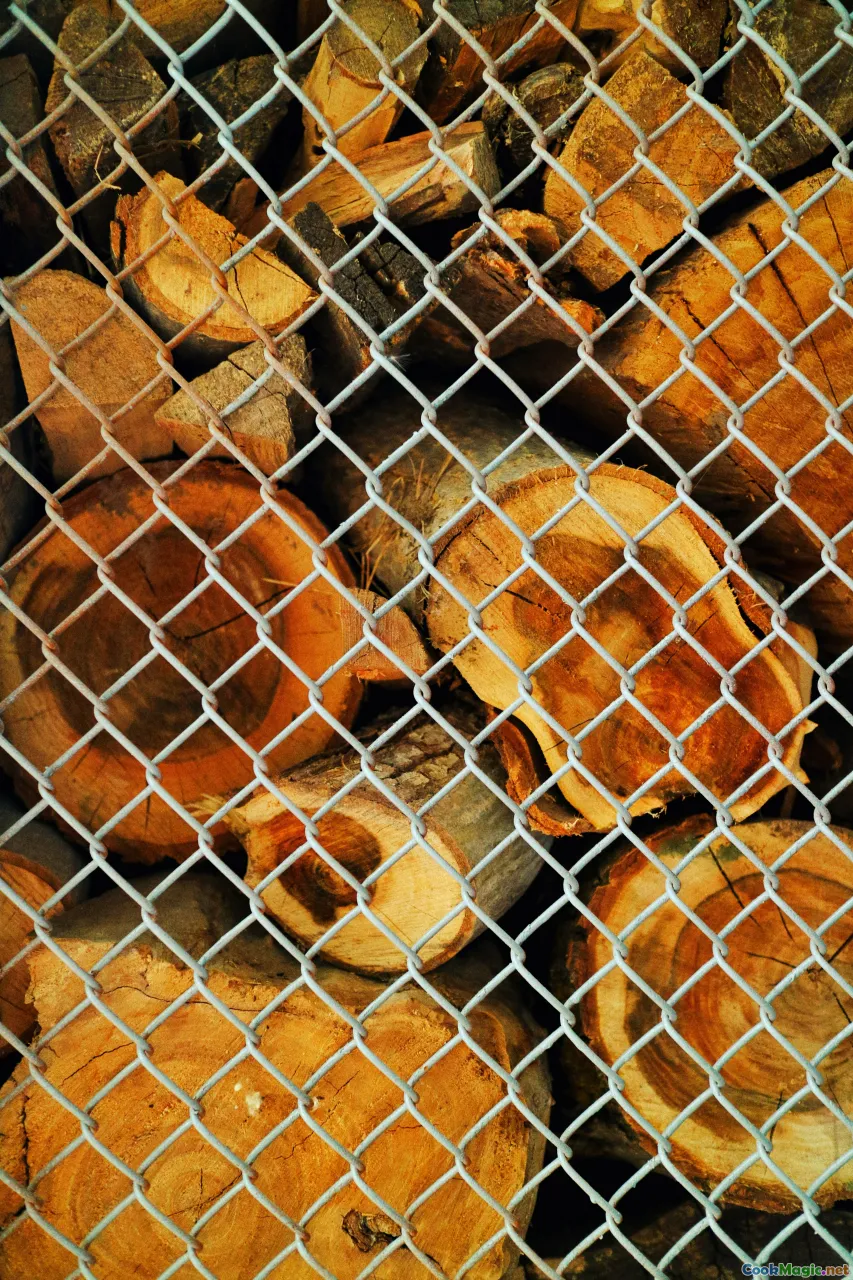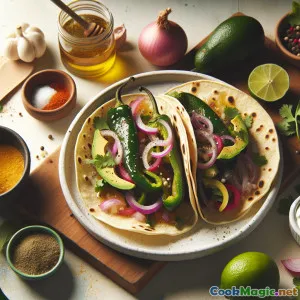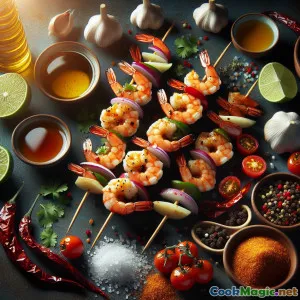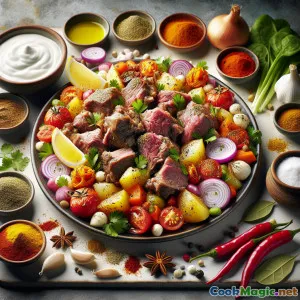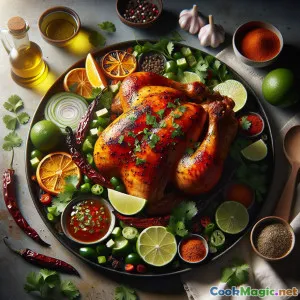
龙舌兰-烟熏辣椒柑橘风味烤鸡
(Agave-Chipotle Citrus Roasted Chicken)
(0 评论)食材
-
1.6 kg 整只鸡,背脊骨去除并摊平
(Remove backbone and flatten; pat very dry)
-
2 pieces Chipotle peppers in adobo
(Seeds removed for less heat)
-
2 tbsp Adobo sauce (from the can)
(增加烟熏的深度)
-
3 tbsp 龙舌兰糖浆
(Light amber preferred for balanced sweetness)
-
2 tbsp 新鲜青柠汁
(大约1个大型青柠)
-
60 ml 新鲜橙汁
(Adds floral citrus to balance heat)
-
1 Orange 橙皮
(Zest before juicing)
-
4 cloves 大蒜瓣,切碎
(新鲜剁碎,味道最佳)
-
1.5 tsp 磨碎的孜然
(Toasty and earthy base)
-
1 tsp 熏制红椒粉
(Enhances chipotle smokiness)
-
1 tsp Dried oregano (Mexican if possible)
(Citrusy, resinous note)
-
2 tsp 犹太洁食盐
(Use less if using table salt)
-
1 tsp 现磨黑胡椒
(根据口味调整)
-
1.5 tbsp 橄榄油
(Helps crisp the skin)
-
1 large 黄洋葱,厚切片
(Roasts under chicken for flavor)
-
120 ml 低钠鸡汤
(For pan sauce or glazing)
-
1 tbsp 无盐黄油
(Silkens the final glaze)
-
1 tsp 玉米淀粉
(For thickening glaze if needed)
-
2 tbsp 新鲜香菜(切碎)
(装饰)
-
4 pieces 青柠檬楔
(用于上菜)
(Remove backbone and flatten; pat very dry)
(Seeds removed for less heat)
(增加烟熏的深度)
(Light amber preferred for balanced sweetness)
(大约1个大型青柠)
(Adds floral citrus to balance heat)
(Zest before juicing)
(新鲜剁碎,味道最佳)
(Toasty and earthy base)
(Enhances chipotle smokiness)
(Citrusy, resinous note)
(Use less if using table salt)
(根据口味调整)
(Helps crisp the skin)
(Roasts under chicken for flavor)
(For pan sauce or glazing)
(Silkens the final glaze)
(For thickening glaze if needed)
(装饰)
(用于上菜)
营养
- 份量: 4
- 每份大小: 1 plate (220g cooked chicken)
- Calories: 520 kcal
- Carbohydrates: 0 g
- Protein: 46 g
- Fat: 28 g
- Fiber: 1 g
- Sugar: 12 g
- Sodium: 750 mg
- Cholesterol: 155 mg
- Calcium: 40 mg
- Iron: 2 mg
制作步骤
-
1 - Prep the chicken:
Spatchcock the chicken by removing the backbone with kitchen shears, then flatten by pressing the breastbone. Pat very dry with paper towels for optimal browning.
-
2 - Make the Marinade:
Blend chipotle peppers, adobo sauce, agave, lime juice, orange juice, orange zest, garlic, cumin, smoked paprika, oregano, salt, black pepper, and olive oil to a smooth paste.
-
3 - Season and rest briefly:
Loosen skin over breasts and thighs. Rub half the marinade under the skin and the rest all over. Let sit 15–20 minutes at room temperature while you preheat the oven.
-
4 - Preheat and set the pan:
Heat oven to 230°C/450°F. Scatter onion slices on a rimmed sheet or skillet to create a bed. Place chicken skin-side up on onions.
-
5 - Roast at high heat:
Roast 20 minutes to start rendering fat and crisping the skin. Rotate the pan for even color if needed.
-
6 - Mix glaze:
In a small saucepan, combine any remaining marinade in the bowl with chicken stock. Simmer 2–3 minutes; whisk in butter. If desired, thicken with cornstarch slurry.
-
7 - Baste and finish roasting:
Reduce oven to 200°C/400°F. Brush chicken with glaze and continue roasting 20–25 minutes until thighs reach 74°C/165°F and juices run clear. Baste once more midway.
-
8 - Rest the bird:
Transfer chicken to a board and rest 10 minutes to redistribute juices. Toss roasted onions in pan drippings.
-
9 - Optional pan sauce:
Deglaze the roasting pan with a splash of stock over medium heat, scraping browned bits. Reduce to syrupy; adjust seasoning.
-
10 - Carve and Serve:
Carve into breasts, thighs, drums, and wings. Garnish with cilantro, serve with roasted onions, extra glaze or pan sauce, and lime wedges for squeezing.
Spatchcock the chicken by removing the backbone with kitchen shears, then flatten by pressing the breastbone. Pat very dry with paper towels for optimal browning.
Blend chipotle peppers, adobo sauce, agave, lime juice, orange juice, orange zest, garlic, cumin, smoked paprika, oregano, salt, black pepper, and olive oil to a smooth paste.
Loosen skin over breasts and thighs. Rub half the marinade under the skin and the rest all over. Let sit 15–20 minutes at room temperature while you preheat the oven.
Heat oven to 230°C/450°F. Scatter onion slices on a rimmed sheet or skillet to create a bed. Place chicken skin-side up on onions.
Roast 20 minutes to start rendering fat and crisping the skin. Rotate the pan for even color if needed.
In a small saucepan, combine any remaining marinade in the bowl with chicken stock. Simmer 2–3 minutes; whisk in butter. If desired, thicken with cornstarch slurry.
Reduce oven to 200°C/400°F. Brush chicken with glaze and continue roasting 20–25 minutes until thighs reach 74°C/165°F and juices run clear. Baste once more midway.
Transfer chicken to a board and rest 10 minutes to redistribute juices. Toss roasted onions in pan drippings.
Deglaze the roasting pan with a splash of stock over medium heat, scraping browned bits. Reduce to syrupy; adjust seasoning.
Carve into breasts, thighs, drums, and wings. Garnish with cilantro, serve with roasted onions, extra glaze or pan sauce, and lime wedges for squeezing.
关于 龙舌兰-烟熏辣椒柑橘风味烤鸡 :的更多信息
Why this recipe works
Agave Chipotle Roasted Chicken marries the natural sweetness of agave nectar with the smoky, earthy heat of chipotle peppers in adobo. The balance is crucial: agave’s clean sweetness complements the chipotle’s depth without tipping into cloying territory, while citrus (lime and orange) brightens the entire profile and helps tenderize the meat. Spatchcocking the chicken ensures even roasting and maximizes crispy skin. By starting at high heat, you jumpstart rendering and browning; finishing at a slightly lower temperature gives time for the glaze to set and the meat to cook through without burning the sugars.
Technique notes and tips
- Dryness equals crispness: Moisture is the enemy of crisp skin. Pat the chicken very dry and avoid overcrowding the pan.
- Under-the-skin seasoning: Rubbing marinade under the skin gets flavor directly onto the meat while preserving a lacquered, crisp exterior.
- Layered roasting bed: Onions beneath the bird subtly perfume the drippings and prevent scorching, creating a built-in side and flavorful base for an optional pan sauce.
- Heat management: The initial 230°C/450°F phase kickstarts browning. Reducing to 200°C/400°F prevents the agave from darkening too fast. If your oven runs hot, tent loosely with foil in the final minutes.
- Glaze consistency: Thicken slightly for a glossy finish that clings without dripping away. A teaspoon of cornstarch slurry does the trick if your glaze seems thin.
- Doneness cues: Beyond the 74°C/165°F target, look for clear juices and a slight resistance when the thigh joint is probed—signs of perfectly cooked, still-juicy meat.
Ingredient insights
- Agave nectar: Historically used in Mexico for sweetness and fermentation, agave offers round sweetness with fewer bitter notes than honey. Light amber agave is ideal here, letting chipotle and citrus shine.
- Chipotle in adobo: Chipotles are smoke-dried jalapeños; the adobo sauce—tomato, vinegar, spices—adds tang and umami. Two peppers bring medium heat; adjust to your preference.
- Mexican oregano vs. Mediterranean: Mexican oregano has a citrusy, slightly floral profile that complements chiles and citrus. It’s worth seeking out for this dish.
- Citrus duo: Lime provides sharp, zesty acidity while orange adds fragrance and a marmalade-like undertone when reduced with agave.
Serving suggestions
- Sides: Try cumin-lime roasted sweet potatoes, charred corn salad with cotija, or a simple jicama and orange slaw.
- Starches: Cilantro-lime rice, warm tortillas, or cheesy polenta make excellent bases for those savory-sweet pan juices.
- Drinks: A crisp Mexican lager, a grapefruit Paloma, or chilled hibiscus agua fresca.
Make-ahead and leftovers
- Marinate ahead: You can coat the chicken up to 24 hours in advance; refrigerate uncovered for the last 2–4 hours to dry the skin slightly.
- Reheat smart: Warm leftovers at 160°C/325°F, uncovered, to re-crisp. Brush with a little reserved glaze to refresh flavor.
- Repurpose: Shred leftover meat for tacos with pickled red onions, fold into quesadillas with Oaxaca cheese, or top a chipotle Caesar salad.
Cultural context and history
Agave has deep roots in Mesoamerican culture—beyond sweetener, agave sap (aguamiel) and its fermented form, pulque, were historically significant. Today, agave nectar provides a modern, accessible way to bring that heritage into the kitchen. Chipotle, meanwhile, showcases a preservation technique prized in central and southern Mexico: smoke-drying ripe jalapeños intensifies sweetness and introduces captivating smoke. Pairing agave and chipotle reflects a broader Mexican culinary sensibility—balancing heat, acidity, sweetness, and aromatics for multidimensional flavor.
Unique aspects
- Spatchcock + glaze synergy: Flattening creates even exposure so the agave-chipotle glaze caramelizes uniformly, avoiding burnt edges and underdone joints.
- Citrus-forward approach: Many recipes use only lime; the addition of orange zest and juice elevates the aroma and tames the heat without extra sugar.
- Onion roasting bed: Simple, inexpensive, and quietly transformative—your drippings won’t burn, and you gain jammy, chile-scented onions.
Troubleshooting
- Skin too dark before cooked through: Lower heat by 10–15°C and tent with foil; continue to temperature. Brush with fresh glaze just before serving for shine.
- Glaze too spicy: Add a splash more orange juice and a teaspoon of agave, then simmer to balance.
- Too sweet: Increase lime or add a teaspoon of apple cider vinegar to sharpen.
Food safety
Always wash hands after handling raw poultry. Use a dedicated cutting board, sanitize tools, and confirm doneness with an instant-read thermometer at the thigh’s thickest point (74°C/165°F).
Personal note
What I love about this dish is its generosity: with little active time, you get restaurant-level flavor. The kitchen fills with aromas of warm citrus, woodsmoke, and caramelizing sugars, and the results are reliably impressive—perfect for a weeknight celebration or casual weekend gathering. Each bite lands in layers: a crisp, lacquered skin; tender, juicy meat; and a finish of bright lime. It’s a plate that feels both comforting and distinctly Mexican in character—rooted in tradition yet streamlined for everyday cooking.


